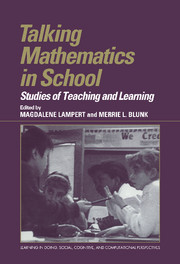Part II - Teaching Mathematical Talk
Published online by Cambridge University Press: 04 August 2010
Summary
Chapters 6, 7, 8, and 9 all study lessons from the same class – the fifth-grade mathematics class from which the example at the beginning of the book is drawn. In chapter 6, Magdalene Lampert provides an overview of the issues involved in studying the teaching of mathematical discourse in school. She describes the investigation of her own practice as a fifth-grade mathematics teacher and the data base which was created around it: records of teaching and learning mathematics for every day across a whole school year. Peggy Rittenhouse, Merrie Blunk, and Peri Weingrad use that data base to analyze the teaching in Lampert's classroom as an intervention in how students talk about mathematics. Finer and finer lenses are applied to tease apart just what the teacher does to model, support, and maintain mathematical discourse.
Rittenhouse reconceives the teacher's role in terms of promoting mathematical “literacy.” She calls what the teacher does in that role “stepping in” and “stepping out” to emphasize the dual nature of the teacher's participation in classroom talk. Blunk investigates one element of the teacher's stepping in to classroom discourse. She examines, across the entire school year, what the teacher says to her class about working on mathematics with their peers in small groups. She argues that norms of peer interaction are deliberately established by teacher intervention and, once established, require continuing intervention to be maintained.
- Type
- Chapter
- Information
- Talking Mathematics in SchoolStudies of Teaching and Learning, pp. 151 - 152Publisher: Cambridge University PressPrint publication year: 1998



